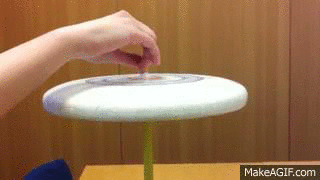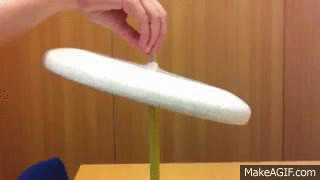April 8, 2014 by Benji Heywood in Analysis with 34 comments
What is wobble? How does it relate to the spin on the disc? And why are some people so much better than others at throwing upwind?
I’ve been asking around a fair bit recently, and it seems that everyone I speak to tells me that wobble is essentially a lack of spin. This hints at the truth in an important way, but it misses some key ideas. And the implications of these ideas are pretty significant – particularly if you’re throwing into the wind.
 Wobble is actually pretty easy to define.
Wobble is actually pretty easy to define.
When objects spin, they do so about a particular axis; you can see it visually here. (All rotation is about some axis, though there’s usually no stick to show where it is.) When the axis is perpendicular to the disc – e.g. a horizontal disc and a vertical axis, as it (nearly) is here – there will be no wobble, regardless of how fast or slow it spins.
 If we keep our vertical axis of rotation, but move the disc away from the horizontal, this is what happens.
If we keep our vertical axis of rotation, but move the disc away from the horizontal, this is what happens.
Wobble is no more or less than the axis of rotation being something other than perpendicular to the disc.
Of course, the axis isn’t always vertical in Ultimate – if we throw inside out, for example, we tilt both the disc and its axis of rotation – but we have to tilt them by the same amount or we’ll have a wobbling disc. You can imagine rotating that whole first image either left or right to demonstrate a roll curve (outside-in throw) or an I/O, tilting the axis and the disc. But if you tilt the disc and not the axis of rotation – or vice versa – you get something like the second image.
In a frisbee throw, wobble will be caused if the angle at which your wrist or fingers impart spin is not lined up with the orientation of the disc. It’s really that simple.
So why do so many of us think that wobble is a lack of spin? There are two very good reasons.
One is that spin damps wobble. If something is spinning fast enough, the initial wobble will quickly decline. Much of the time, you won’t even notice the wobble on your throws since it gets damped so quickly, but it’s there very clearly if you can watch your throws in slow-motion – and it’s probably an awful lot worse than you realise early in the throw. We borrowed some high-frame-rate cameras from the Old Course here in St. Andrews for our preseason a couple of years ago – here’s the wobbliest, slowest-spinning video I can find from when we were testing the camera, and you still see it smooth out in the first ten or fifteen yards.
And secondly, spin can prevent wobble being induced. The lift force on a flying disc doesn’t act on the center of the disc, but towards the front or back (this is complicated – but see this thesis if you want something really technical). Because that lift force is generally in a different place to the effect of gravity, these two forces will act to twist the disc.1 A strong wind (particularly a gusty wind) can induce wobble by unevenly lifting that front edge.
Spin enables the disc to resist twisting and wobbling because of the disc’s angular momentum, just like a gyroscope. But if you don’t have enough spin to stabilize the disc against the off-center lift force, then your throws will have no chance. For a beginner who generates very little spin, the airspeed may be enough to induce wobble even when throwing gently on a still day.
So – more spin is both an effective way to damp initial wobble, and an effective way to stop wobble being induced. Why then am I worrying about wobble at all? If we simply coach that “more spin = less wobble,” isn’t that good enough?
One of our graduates up here in St. Andrews used to have an identical backhand to me when going downwind — same sort of distance, same flight path, same ability to hold its line at the end — implying that neither the spin nor the velocity on the disc were much different.2 But upwind, he was unable to throw it half-pitch as it flipped horribly into a blade early in the flight.
The same pattern held regardless of whether we attempted to throw low or high, I/O or roll curve – we could match each other’s throw downwind, but not upwind. If the spin and velocity were broadly similar, then the only explanation for the difference is the wobble he put on the disc.
Wobble and spin are not the same, and it’s perfectly possible to have lots of spin and lots of wobble just after release – though you may not notice it until you throw in the wind. That wobble early in the throw is easy to ignore until the weather conditions suddenly make it important.
- Wobble creates turbulence, which exacerbates the natural tendency of a high-(air)speed disc to flip over. A fast disc will try to turn to the right (for a right-handed backhand) whereas slowing, stalling throws eventually die left. (Long throws will often do both – turn right early, and die left at the end – resulting in an s-curve.) Wobble and the associated turbulence make this turn to the right much more pronounced, and can completely flip the disc all the way to vertical.3
- That turbulence also costs you distance – you can imagine how much more easily a smooth disc will cut through the air. A wobbling disc moves more air, and hence slows down more quickly.
- And it costs you consistency – a wobbling disc will act much more chaotically (in a mathematical sense) than one thrown smoothly. Just like flipping a coin, a tiny difference in the initial conditions can result in a completely different outcome – as the wobble dies out, the disc could end up becoming stable in any of a variety of orientations, depending on the exact amount of wobble and the precise wind profile. You can’t throw the same throw twice if wobble is an issue.4
I guarantee that the throw you see in the video above would never work into the wind.
From the point of view of a disc in flight, a throw into the wind is equivalent to throwing much harder on a still day. And generally when you throw harder you get more spin, but here you don’t. The spin is similar to your normal throw, but the airspeed and the associated turbulence are much higher, and so the spin can’t overcome the wobble as it normally would. Whether it’s a 5-yard toss or a 50-yard throw, the spin/airspeed ratio is inevitably less favorable into the wind, and both initial and induced wobble will be more of a problem.
***
Phew – all that was very technical. But the takeaway is hugely important. Throwing better – perhaps even throwing further – is not just about throwing with more spin or more power, but also about throwing more smoothly. Most people have a vague idea that a smooth release is important because it helps you to generate spin or power; but in fact it’s quite possible for two throwers with identical spin and power to have very different results if one has not paid attention to the smoothness and alignment of the release.
For those 5-yard passes that you struggle with in the wind, it’s likely to be induced wobble that is the issue – you don’t snap it enough, and more spin is the answer. If your hucks travel nicely for a while and then get killed by a gust, that’s probably a spin issue also – there’s not enough stability to fight the induced wobble.
But if your throws hold their line nicely downwind, but flip straight out of the hand when thrown upwind, an excess of wobble at release is highly likely to be the issue. And fixing that is not rocket science – get the disc aligned with the axis of rotation, and throw it smoothly.
If that isn’t clear, hold a disc with one finger below and one on top, in the middle, pressing against each other. The finger below represents lift pushing up, and the finger above represents gravity pushing down. As long as they are in the same place, the disc is stable, but if you move one of them, the disc twists. Only the gyroscopic stability provided by the spin counteracts this natural tendency to twist. ↩
That dying-off at the end of a disc’s flight, which makes the read harder and dives the disc into the ground earlier, can be controlled by increasing spin. Spin gives the disc stability, so (loosely) more of it makes it more stable, and this is particularly noticeable towards the end of a throw when spin is starting to decline — if you didn’t have much spin to start with, you’ll have virtually no stability late in the flight. So additional spin helps prevent a disc dying left (for a right-handed backhand), and generally makes it want to stay flat for most of its flight. You can tell if two people generate similar amounts of spin by watching what happens at the end of their similar-distance throws. ↩
A good example of the effects of turbulence can be seen in frisbee golf discs – as the rim of the disc gets beaten up, there will be more turbulence at the edge and the disc will tend to turn right at lower speeds (or turn more sharply right at the same speed) than when it was new and smooth. Disc golfers often carry two or three of the same brand of disc, in various states of disrepair, in order to get the different flight paths. [Technically, it can be argued that it’s the angle of attack to the air and not the speed of a disc that affects whether it flips right or dies left (see the Hummel thesis linked above) but speed is a close enough approximation for our purposes. Similarly, if for example a disc is extremely I/O, it may never actually turn right – but still, early in the throw, the right edge will drop relative to the left edge, and this is reversed as the disc slows. Again, flipping right and dying left are close enough for a basic understanding.] ↩
Imagine throwing a smooth disc when the wind is varying randomly by only a small amount – the airspeed, and hence the amount of high-speed turn on the disc, will vary by a similarly small amount. But with a wobbly disc, that tiny, imperceptible gust may happen when the bottom of the disc is facing the wind, or when the top is, or when the disc is nicely aligned, and the results are completely unpredictable. ↩